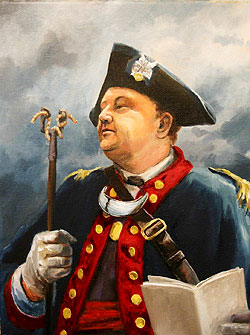People
William Stevens

William Stevens
© 2008 Bryant White
Born in England in 1750(1), William Stevens, junior, was one of five surviving children born to William and Mary Stevens. When William was 10, his family emigrated to Dedham, Massachusetts, where his father worked as a weaver. When he was 22, William married Elizabeth Gurney. Stevens was extremely interested in artillery, especially heavy ordnance. According to one story, before war broke out in 1775, young William was fascinated by the artillery drills of the British army stationed in Boston. He eagerly questioned the officers supervising the drills, until one of them jokingly remarked that they might be making a mistake in imparting information to a young colonial who one day might be firing artillery at them.(2)
From the spring of 1775 on, William Stevens was a soldier, serving first in the Massachusetts militia, and then in the Continental Army. In January, 1776, the year his first child Betsey was born, he was promoted to 1st Lieutenant in General Henry Knox's regiment of Continental Artillery. He advanced steadily through the ranks, proving himself as an officer and an artillerist. William Stevens wrote the only textbook on the artillery of the Revolution: A System for Discipline of the Artillery of the United States. Reputed to be one of the most skillful gunners in the Continental Army, a family story reveals Steven's courage and temper. During the Battle of Monmouth, New Jersey, in 1778, Major General Charles Lee ordered Stevens, who was commanding artillery, to retreat. Instead of obeying, Stevens told Lee to "go to hell" and held his position until General Washington arrived. General Henry Knox gave Stevens a battlefield promotion on the spot for unusual courage and bravery in action. As the war drew to a close, Major Stevens was one of the earliest members of the Society of the Cincinnati, an organization founded by and for Continental Army officers and their eldest male descendents.
After eight years of military service, William was thirty-four years old and trying to launch a successful civilian career. In 1784, William Stevens of Dedham, "a gentleman," bought 100 acres of land in Colrain, Massachusetts, for £300. William opened a general store. His land holdings, rank and distinguished military service contributed to his status as a gentleman. Colrain residents acknowledged it by electing Williams as a selectman for the town. His activities suggest that Stevens was trying to integrate himself into his new community by taking on the responsibilities expected of a man of status. In the winter of 1787, however, Stevens would permanently alienate most of his neighbors.
Like most Continental officers, William Stevens sided with the Massachusetts government during Shays' Rebellion. He put his artillery expertise to work for the government militia. It was Major Stevens who commanded the artillery that fired on the Regulators at the United States Arsenal [artifact] (arsenal) at Springfield, Massachusetts, on January 25, 1787.

Major William Stevens commanded the artillery at the Arsenal that killed four
Regulators and wounded over twenty more.
The people of Colrain never really forgave Stevens for his willingness to fire upon his fellow citizens. Like Colonel Hugh McClellan, Williams also received death threats in the winter of 1787.(3) Unlike McClellan, however, Stevens seems not to have interceded with the government on behalf of any of the men arrested in the wake of the insurgency. His situation in Colrain could not have been easy. According to the United States Census for 1790, Major William Stevens was still living in Colrain, with two males over 16 (three in all), five males under 16, and four females. Since Williams and Elizabeth had only three children, other family members may also have been living with them. By 1793, Stevens had sold his Colrain property and moved to Onondaga, New York, to take possession of 1,800 acres he had received in reward for his military service.(4) Once again, William was offered offices in his new community that reflected his status. Referred to in legal documents as "Esquire," he was held town offices in the town of Camillus and was appointed Judge of the Court of Common Pleas for Onondaga County. When New York declared the mining and marketing of salt to be a State monopoly, William was chosen to serve as the first Superintendent of the New York State Salt Works, located near near Syracuse. When Elizabeth died in 1795, he remarried. Williams Stevens died suddenly in 1801; his second wife Hannah (Frisbie) Stevens survived him, dying at the age of 98 in 1845.
About This Narrative
Note: All narratives about people are, to the extent possible, based on primary and secondary historical sources.
See Further Reading for a list of sources used in creating this narrative. For a discussion of issues related to telling people's stories on the site, see: Bringing History to Life: The People of Shays' Rebellion
| Print | Top of Page